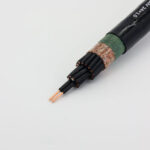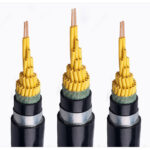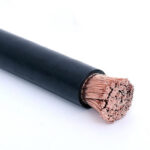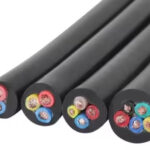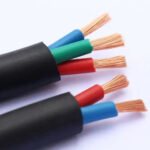Recent updates to electrical installation standards provide clearer guidance on proper wire sizing for high-amperage residential circuits
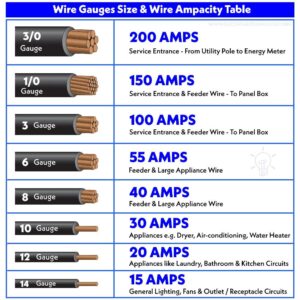
what gauge wire for 50 amp
March 15, 2025 - As American homes increasingly rely on high-powered appliances like electric vehicle chargers, heat pumps, and electric ranges, electrical safety experts are emphasizing the critical importance of proper wire sizing for 50-amp circuits. Recent clarifications from the National Electrical Contractors Association (NECA) have provided updated guidance on what gauge wire for 50 amp installations, addressing growing confusion among homeowners and contractors alike.
Rising Demand for 50-Amp Circuits Drives Safety Concerns
The surge in electric vehicle adoption and energy-efficient home appliances has led to a dramatic increase in 50-amp circuit installations across the United States. According to the Electrical Safety Foundation International, improper wire sizing remains one of the leading causes of residential electrical fires, making proper gauge selection more crucial than ever.
'We're seeing a 40% increase in 50-amp circuit installations compared to five years ago,' said Sarah Mitchell, a certified master electrician with over 20 years of experience. 'The most common question we get is 'what size wire for 50 amp' circuits, and getting this wrong can have serious consequences.'
Industry Standards Provide Clear Wire Sizing Guidelines
Current electrical code standards specify that 6 AWG copper wire is the standard choice for most 50-amp residential applications. This wire gauge provides a 65-amp capacity, offering the necessary safety margin required by the National Electrical Code (NEC).
For installations using aluminum wiring, 4 AWG aluminum wire is required to handle the same 50-amp load safely. The larger gauge compensates for aluminum's lower conductivity compared to copper.
'The question of what gauge wire for 50 amp circuits has a straightforward answer for most residential applications,' explains electrical contractor James Rodriguez. 'Six-gauge copper wire is your go-to choice, but there are important factors homeowners need to consider.'
Distance and Installation Method Affect Wire Selection
Recent updates to installation guidelines emphasize that wire sizing isn't just about amperage. The distance between the electrical panel and the appliance significantly impacts the required wire gauge.
Key factors affecting wire size selection:
- Circuit length: Runs over 100 feet may require larger gauge wire
- Installation method: Conduit installations vs. direct burial affect heat dissipation
- Ambient temperature: High-temperature environments require additional capacity
- Voltage drop considerations: Longer runs require compensation for power loss
'Many homeowners don't realize that a 50-amp circuit serving an EV charger 150 feet from the main panel might need 4 AWG copper wire instead of the standard 6 AWG,' notes electrical inspector David Chen. 'It's not just about what size wire for 50 amp circuits in general – it's about your specific installation.'
Electric Vehicle Charging Drives Installation Surge
The rapid adoption of electric vehicles has made 50-amp circuits a standard feature in new home construction and renovation projects. Level 2 EV chargers typically require dedicated 50-amp circuits to provide optimal charging speeds.
Tesla and other EV manufacturers recommend 50-amp circuits for their home charging stations, leading to increased awareness about proper electrical installation. However, this surge in DIY interest has also raised safety concerns among electrical professionals.
'We've seen a troubling trend of homeowners attempting their own 50-amp installations after researching what gauge wire for 50 amp circuits online,' warns electrical safety advocate Maria Santos. 'While the information is readily available, proper installation requires understanding local codes, proper grounding, and safety procedures that go beyond just wire sizing.'
Cost Considerations Drive Material Choices
The choice between copper and aluminum wiring often comes down to cost considerations, with aluminum offering significant savings for larger installations. However, aluminum wiring requires special connectors and installation techniques to ensure long-term safety.
Current market pricing trends:
- 6 AWG copper wire: $3.50-$4.50 per foot
- 4 AWG aluminum wire: $2.25-$3.00 per foot
- Installation labor: $75-$125 per hour (varies by region)
'When homeowners ask what size wire for 50 amp installations, cost is usually their second question after safety,' observes electrical supply retailer Tom Williams. 'We always recommend getting quotes for both copper and aluminum options, factoring in the total installation cost.'
Safety Experts Emphasize Professional Installation
Despite the availability of online resources explaining what gauge wire for 50 amp circuits, electrical safety organizations strongly recommend professional installation for all high-amperage circuits.
The Electrical Safety Foundation reports that improperly installed 50-amp circuits pose significant risks:
- Fire hazards from undersized wire overheating
- Electrical shock from improper grounding
- Code violations that affect home insurance and resale value
- Equipment damage from voltage irregularities
'Understanding what size wire for 50 amp circuits is just the beginning,' emphasizes licensed electrician Robert Taylor. 'Proper installation involves load calculations, conduit sizing, breaker selection, and grounding – all areas where mistakes can be dangerous and expensive.'
Regional Code Variations Require Local Expertise
While national electrical codes provide baseline requirements, many jurisdictions have specific amendments that affect wire sizing requirements. Some areas require larger wire gauges for certain applications or mandate specific installation methods.
'What gauge wire for 50 amp circuits might have different answers depending on your location,' explains code consultant Angela Foster. 'California's energy efficiency standards, Florida's hurricane codes, and cold-climate requirements all influence proper wire selection.'
Recent updates to local codes in several states have introduced stricter requirements for EV charging installations, often requiring larger wire gauges or additional safety features beyond standard national codes.
Technology Advances Improve Wire Performance
Recent advances in wire manufacturing have introduced improved insulation materials and conductor designs that offer better performance in high-amperage applications. These developments are particularly relevant for 50-amp circuits serving sensitive electronic equipment.
Modern THWN-2 and XHHW-2 rated wires provide superior temperature ratings and moisture resistance compared to older wire types, making them preferred choices for new 50-amp installations.
'When clients ask what size wire for 50 amp applications, we also discuss wire type and insulation ratings,' notes electrical contractor Lisa Park. 'The right wire gauge is essential, but modern insulation materials provide additional safety margins.'
Planning for Future Power Needs
Electrical professionals increasingly recommend oversizing wire installations to accommodate future power needs. With home electrification trends continuing, many 50-amp circuits installed today may need to handle higher loads in the future.
'Smart homeowners are asking not just what gauge wire for 50 amp circuits today, but what will serve their needs for the next 20 years,' observes energy consultant Mark Davis. 'Installing 4 AWG copper instead of 6 AWG might cost more upfront but provides flexibility for future upgrades.'
Expert Installation Recommendations
Industry professionals offer the following guidance for homeowners considering 50-amp circuit installations:
Before Installation:
- Consult local electrical codes and permit requirements
- Calculate total electrical load to ensure panel capacity
- Consider future electrical needs and potential upgrades
- Obtain quotes from licensed electricians
Wire Selection Factors:
- Use 6 AWG copper for standard residential 50-amp circuits
- Consider 4 AWG copper for long runs or future expansion
- Evaluate aluminum wiring for cost-sensitive installations
- Factor in local code requirements and climate conditions
Safety Priorities:
- Always use properly rated breakers and disconnect switches
- Ensure proper grounding and bonding
- Install appropriate conduit and protection
- Schedule inspection by qualified electrical inspector
Industry Outlook and Future Trends
The electrical industry expects continued growth in 50-amp circuit installations as home electrification accelerates. This trend is driving innovation in wire manufacturing, installation techniques, and safety standards.
'The question 'what size wire for 50 amp' installations will only become more important as we transition to electric everything,' predicts industry analyst Jennifer Kim. 'Proper education and professional installation standards are crucial for maintaining electrical safety during this transition.'
Upcoming changes to electrical codes are expected to address emerging technologies and installation scenarios, potentially affecting wire sizing requirements for specific applications.
Conclusion: Safety First in High-Amperage Installations
While understanding what gauge wire for 50 amp circuits is important knowledge for homeowners, electrical safety experts emphasize that proper installation involves much more than wire sizing alone. The combination of increased electrical loads, new technologies, and evolving codes makes professional installation more important than ever.
'Knowledge about what size wire for 50 amp circuits is valuable for homeowners,' concludes electrical safety educator Dr. Patricia Williams. 'But this knowledge should inform better conversations with electrical professionals, not replace their expertise. Safety must always be the top priority in electrical installations.'
As home electrification continues to advance, proper electrical installation practices become increasingly critical for safety, efficiency, and code compliance. Homeowners planning 50-amp circuit installations should prioritize professional consultation and installation to ensure safe, reliable electrical service for years to come.

